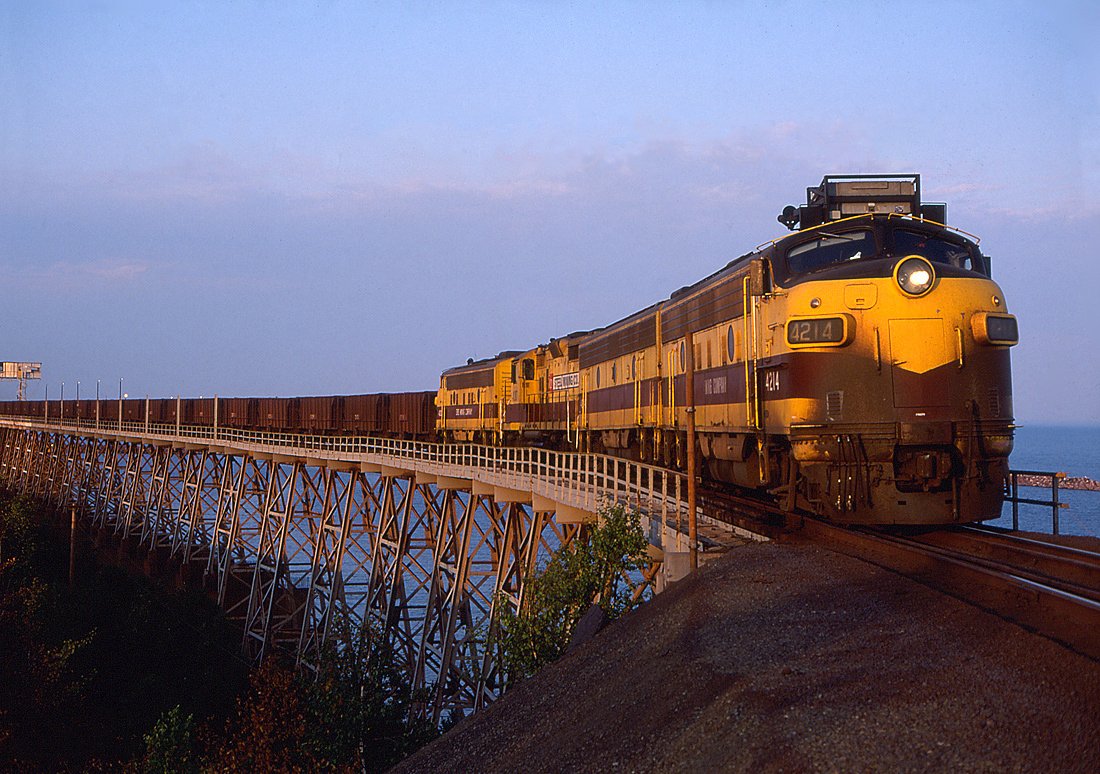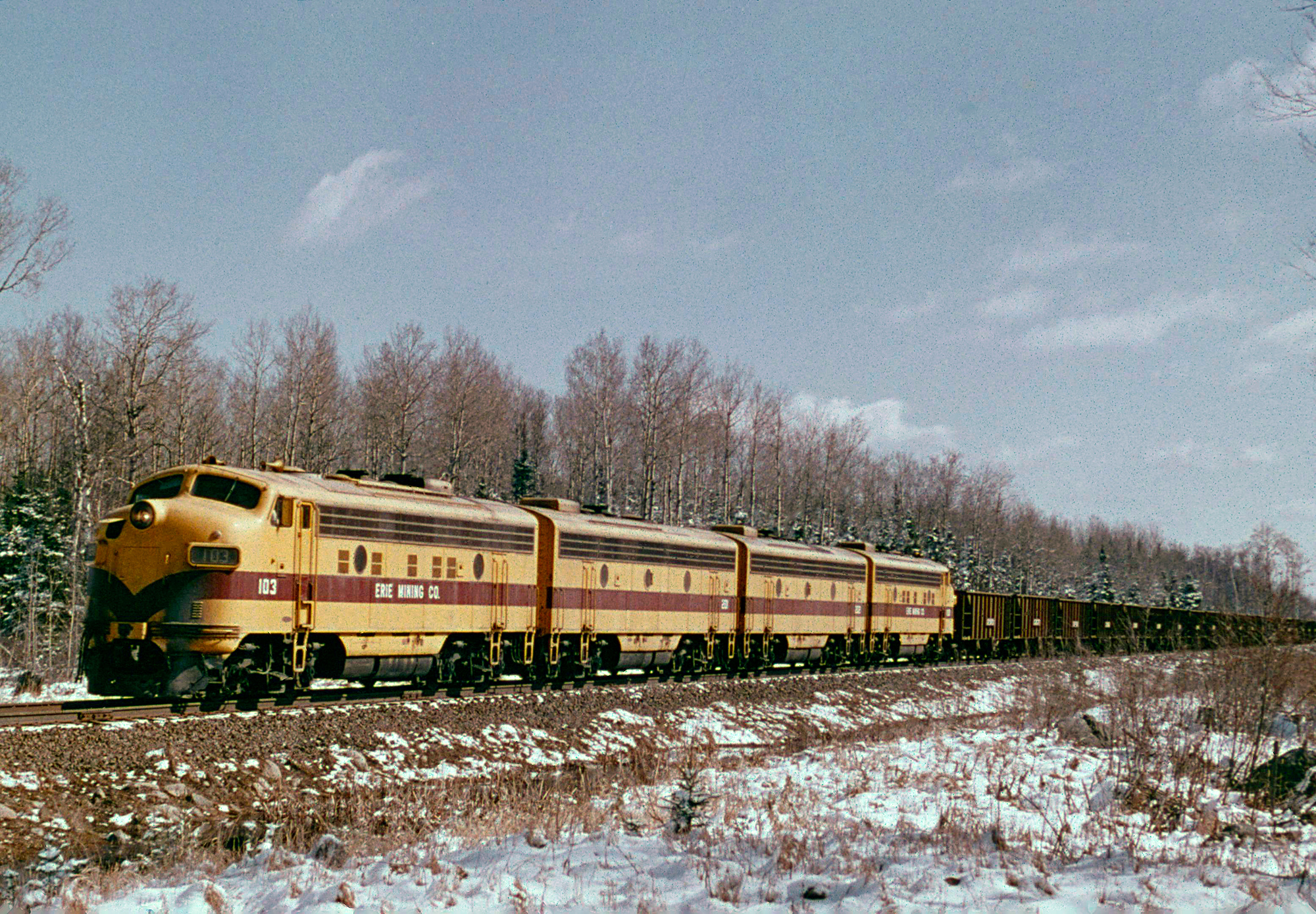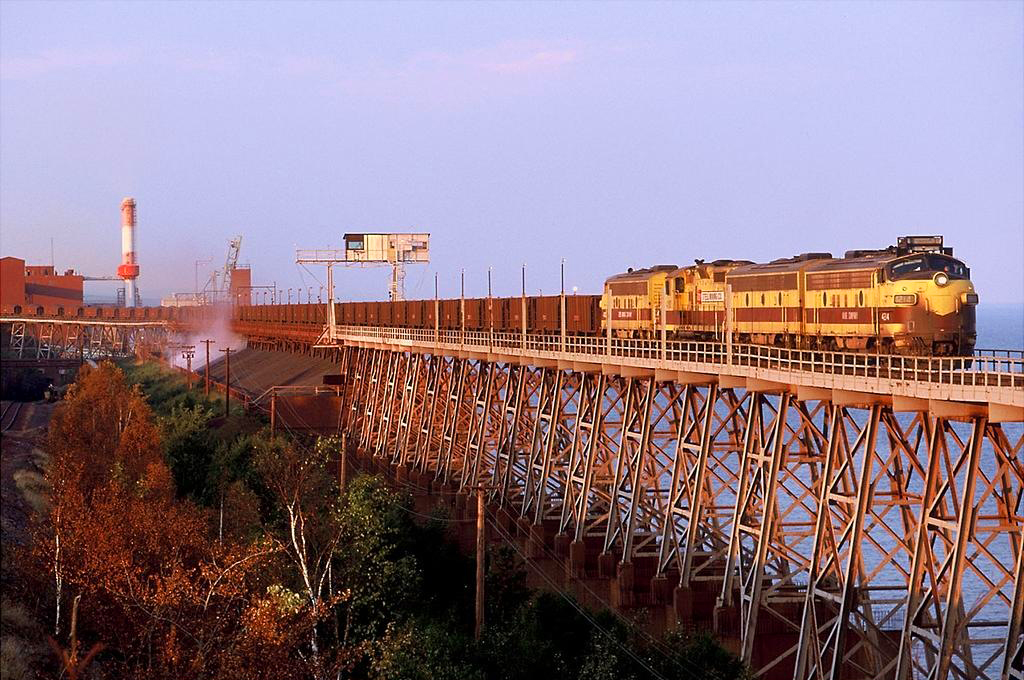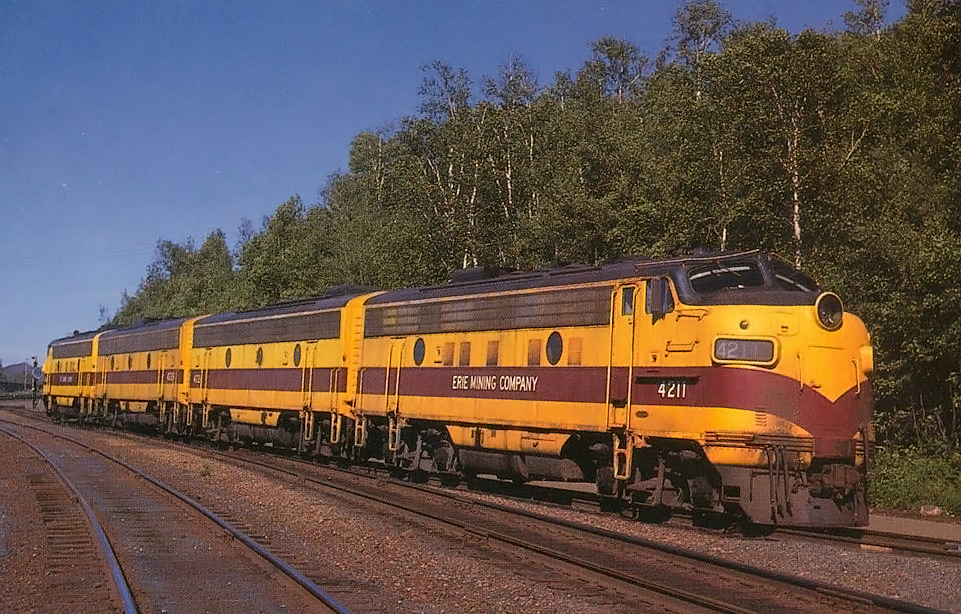Erie Mining Company Railroad: History, Roster, F9s
Last revised: February 24, 2025
By: Adam Burns
The Erie Mining Company was established in the 1940s with the goal of exploring the commercial viability of taconite mining. By 1948, they had selected a site near Aurora in Northern Minnesota to construct a processing plant.
Fast forward to 1954, and construction began in earnest on a pellet plant at Hoyt Lake, complemented by a 1,200-foot ore dock and several supporting structures at Taconite Harbor. The project was completed in 1957.
Following three decades of operation, Erie was acquired by LTV Steel in 1987 and operations continued until 2001 following the latter's bankruptcy in late 2000. Afterwards, the sale to Cleveland Cliffs in 2002 saw the railroad occasionally utilized to move leftover chips and pellets until 2008.
Erie Mining's railroad operations were constructed at a very late period in the industry but early enough that Electro-Motive was still cataloging its final F series locomotives, the F9.
For whatever reason - when the utilitarian road-switcher had already proven its worth - Erie elected to acquire 11 examples of EMD's final streamlined cab model in 1956. They were some of the last of their kind to operate in revenue service and became a railfan favorite for decades.
 An Erie Mining/LTV Steel ore train is unloaded at the Lake Superior Ore Dock in Taconite Harbor, MN on August 16, 1994. Wade Massie photo.
An Erie Mining/LTV Steel ore train is unloaded at the Lake Superior Ore Dock in Taconite Harbor, MN on August 16, 1994. Wade Massie photo.History and Peak Years
In 1940, under the leadership of Pickands Mather, the Erie Mining Company was established with the goal of acquiring taconite lands and developing the necessary mining and processing techniques.
By 1947, Pickands Mather announced plans for Erie to construct a demonstration plant aimed at converting taconite ore into pellets. This process, which required three tons of taconite to produce one ton of pellets and two tons of tailings, necessitated a massive facility.
The Erie plant opened in 1957, at a total cost of $300 million, which was considered astronomical at the time. The construction, which took four years to complete, included a mine and processing plant near Aurora and a newly established town named Hoyt Lakes, in honor of mining engineer Elton Hoyt II.
The project required 50,000 pounds of structural steel, 370,000 cubic yards of concrete, and 122 total miles of railroad track to connect Erie with the North Shore.
Additionally, the plant site involved the excavation of 5.3 million cubic yards of soil, along with 55,000 cubic yards for a power plant, and a million cubic yards at Taconite Harbor on Lake Superior.
At its peak, the workforce numbered more than 6,000 employees. Erie reached a significant production milestone in 1970, marking a period of prosperity from 1967 to 1976.
 Erie Mining F9's in service near Babbitt, Minnesota; May 2, 1970. Jim Jeffrey photo. American-Rails.com collection.
Erie Mining F9's in service near Babbitt, Minnesota; May 2, 1970. Jim Jeffrey photo. American-Rails.com collection.Railroad Operations
The railroad that emerged from this initiative spanned 72.2 route miles, presenting significant engineering challenges.
Builders had to blast deep cuts through solid basaltic rock, meticulously grade high fills on the descent toward the dock, and bore the 1,860-foot Crammer Tunnel.
Service over the line commenced in 1957 following the acquisition of F9s the previous year. Over the years, the railroad's fleet consisted of a mix of EMD, Alco, and Baldwin power. Much of this was purchased new although a handful of units were acquired second-hand.
LTV Steel Acquisition
In 1987 Erie Mining was acquired by LTV Steel, leading to the rebranding of its railroad as the LTV Mining Railroad. LTV proved a less than ideal acquisitionn with the latter struggling financially on and off over the next 13 years. It initially filed for bankruptcy around the time it had acquired Erie and would do so again in late 2000.
Production continued through the 1990s but with an oversupply of steel, worldwide, at the time and a need to overhaul Erie's blast furnances at a cost of $500 million - according to then-LTV Steel president Roger Hipple - put the operation on borrowed time.
Then, a second LTV bankruptcy in late 2000 abruptly ended everything. According to the book, "Taconite: New Life for Minnesota's Iron Range":
"At 7:15 a.m. on January 2, 2001, Erie's General Manager Dennis Koschak received notification from LTV Steel that operations at the mine were to cease... About noon on January 4 the last crude ore was dumped at the coarse crusher. At 4 a.m. on January 5 the last operating mill line was shut down and at 11:30 a.m. the last operating furnace was shut down."
Diesel Roster
| 1st Road Number | 2nd Road Number | 3rd Road Number | Model Type | Builder | Completion Date | Serial Number | Notes |
|---|---|---|---|---|---|---|---|
| 100-102 | 4210-4212 | - | F9A | EMD | 5/1956 | 20830-20832 | #4210 sold to Vermillion Valley Railroad; #4211 is preserved at the Lake Superior Railroad Museum. |
| 103-104 | 4213-4214 | - | F9A | EMD | 5/1956, 8/1956 | 21048-21049 | #4214 sold to Vermillion Valley Railroad. |
| 200-205 | 4220-4225 | - | F9B | EMD | 7/1956-8/1956 | 21050-21055 | #4222 is preserved at the Lake Superior Railroad Museum. |
| 300-314 | 7200-7214 | - | RS11 | Alco | 6/1956-12/1956 | 81914-81915, 81918-81919, 81929-81930, 81932-81933, 82036-82038, 82041-82042, 82050-82051 | - |
| 400-402 | 7240-7242 | - | S12 | Baldwin | 10/1955 | 76116-76118 | - |
| 403 | 7243 | - | S12 | Baldwin | 10/1955 | 76125 | Last Baldwin built at Eddystone; preserved at the Lake Superior Railroad Museum. |
| 404 | 7244 | - | S12 | Baldwin | 7/1953 | 75846 | ex-Monongahela Railway #415 |
| 405 | 7245 | - | S12 | Baldwin | 6/1954 | 76016 | ex-Monongahela Railway #425 |
| 500 | 7230 | - | C424 | Alco | 10/1964 | 3382-03 | - |
| 600-602 | 350-352 | 7220-7222 | C420 | Alco | 12/1965 | 3437-01 thru 3437-03 | #600-601 once numbered 4218-4219 |
| 700-701 | 7250-7251 | - | GP38 | EMD | 1/1967 | 31949-31950 | - |
| 7215-7216 | - | - | RS11 | Alco | 7/1958 | 82954, 82950 | ex-Burlington Northern #4190 and #4186; built as Northern Pacific #910 and #906. |
| 7246-7247 | - | - | S-12 | Baldwin | 2/1953 | 75821, 75818 | ex-Great Northern #27 and #24. |
| 7248 | - | - | S12 | Baldwin | 4/1954 | 76013 | ex-Monongahela Railway #422 |
| 7260 | 4207 | - | GP20 | EMD | 4/1961 | 26595 | ex-Burlington Northern #2060; built as CB&Q #924. |
| 7261-7262 | 4208-4209 | - | GP20 | EMD | 2/1961, 3/1961 | 26580,26585 | ex-Burlington Northern #2045 and #2050; built as CB&Q #909 and #914. |
 An A-B-A set of Erie Mining/LTV Steel's famous F9's, along with a Geep sandwiched in-between, unload an ore train on the Lake Superior Ore Dock at Taconite Harbor, Minnesota on August 16, 1994. Wade Massie photo.
An A-B-A set of Erie Mining/LTV Steel's famous F9's, along with a Geep sandwiched in-between, unload an ore train on the Lake Superior Ore Dock at Taconite Harbor, Minnesota on August 16, 1994. Wade Massie photo.Final Years
However, the story didn't end there. In 2002, Cleveland Cliffs took over the plant and breathed new life into the railway, aptly renaming it the Cliffs Erie Railroad—a nod to both its Erie Mining and Cleveland Cliffs legacies.
The railroad saw an unexpected revival in 2004 when high iron prices prompted Cliffs Erie to hire a contractor to recover leftover chips and pellets from the mine.
To tackle this task, they employed the only unsold locomotives available, the former F9s, with one borrowed from the Lake Superior Railroad Museum. These workhorses powered the cleanup trains until 2008, making their final run that year.
The F9s
The F9 fleet continued operating at full strength for four decades until the first setback occurred in January, 1997 when a runaway derailment at Taconite Harbor destroyed two A units and two B units.
After operations ended three of the F9Bs were scrapped on site at the Erie plant in Hoyt Lakes in December, 2024 - #4223, #4224, and #4225 - with their prime movers, generators, and most of the trucks sold and shipped out.
It is believed F9As #4210 and #4214 still remain intact at Hoyt Lakes while former F9A #4211 and F9B #4222 are preserved by the Lake Superior Railroad Museum in Duluth.
Recent Articles
-
Colorado - Wine Tasting - Train Rides
Dec 25, 25 08:04 PM
To truly savor these local flavors while soaking in the scenic beauty of Colorado, the concept of wine tasting trains has emerged, offering both locals and tourists a luxurious and immersive indulgenc… -
Kentucky -Wine Tasting- Train Rides
Dec 25, 25 12:15 PM
Kentucky, often celebrated for its rolling pastures, thoroughbred horses, and bourbon legacy, has been cultivating another gem in its storied landscapes; enjoying wine by rail. -
Iowa -Wine Tasting- Train Rides
Dec 25, 25 12:12 PM
In this immersive article, passengers embark on a journey that combines the delights of wine tasting with the nostalgia of a leisurely train ride.




